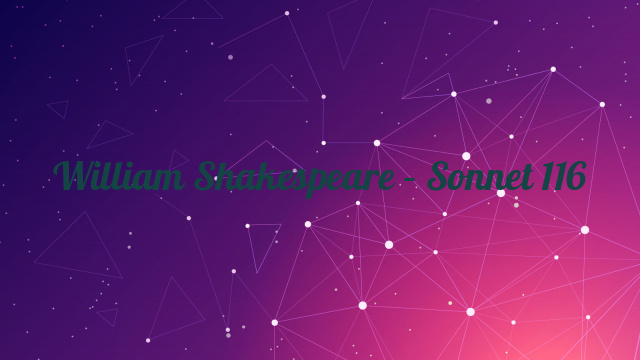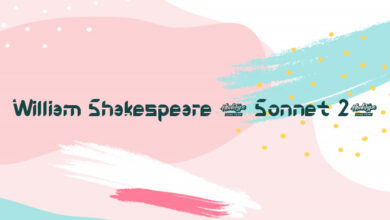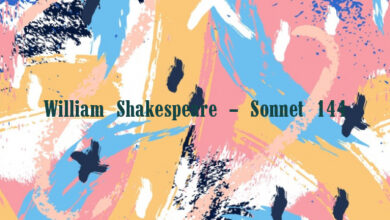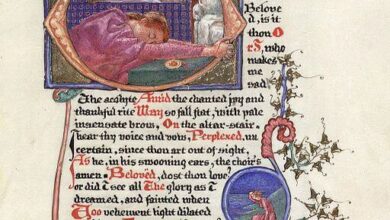
William Shakespeare – Sonnet 116
Let me not to the marriage of true minds
Admit impediments. Love is not love
Which alters when it alteration finds,
Or bends with the remover to remove:
O, no! it is an ever-fixed mark,
That looks on tempests and is never shaken;
It is the star to every wandering bark,
Whose worth’s unknown, although his height be taken.
Love’s not Time’s fool, though rosy lips and cheeks
Within his bending sickle’s compass come;
Love alters not with his brief hours and weeks,
But bears it out even to the edge of doom.
If this be error and upon me proved,
I never writ, nor no man ever loved.
Although in former times this sonnet was almost universally read as a paean to ideal and eternal love, with which all readers could easily identify, adding their own dream of perfection to what they found within it, modern criticism makes it possible to look beneath the idealism and to see some hints of a world which is perhaps slightly more disturbed than the poet pretends. In the first place it is important to see that the sonnet belongs in this place, sandwiched between three which discuss the philosophical question of how love deceives both eye and mind and judgement, and is then followed by four others which attempt to excuse the poet’s own unfaithfulness and betrayal of the beloved. Set in such a context it does of course make it appear even more like a battered sea-mark which nevetheless rises above the waves of destruction, for it confronts all the vicissitudes that have afflicted the course of the love described in these sonnets, and declares that, in the final analysis, they are of no account.
In addition, despite the idealism, there is an undercurrent of subversion which permeates all. It is ironic that a poem as famous as this should be seized on by the establishment as a declaration of their view of what love should be. Does the establishment view take account of the fact that this is a love poem written by a man to another man, and that the one impediment to their marriage is precisely that, for no church of the time, or scarcely even today, permits a man to marry a man? It is useless to object that Shakespeare is here talking of the marriage of true minds, for the language inevitably draws us to the Christain marriage service and its accompanying ceremonies, and that is a ceremony designed specifically to marry two people, not two abstract Platonic ideals which have decided to be wed. It is almost as if the exclamation ‘Oh No!’ in the second quatrain is a recognition of this one great impediment that overhangs all others ‘and all alone stands hugely politic’. (SB notes that the exclamation presents, among other things, ‘a logically incidental example of a suitable prefatory exclamation introducing an impediment volunteered by a parishioner responding to the injunction in the marriage service’).
Of course it is partly due to the slow process of being drawn into the sonnets, with their continuous change and varying cycles of elation and depression, that the view is gradually inculcated into one’s soul that this is a history of love which anyone might have known, a mortal and immortal love such as any two lovers in the tide of times might have experienced, or might even be experiencing now. We tend to forget that it is also an unconventional love, even more unconventional in the Elizabethan world than it is today. But it is precisely this unconventionality that gives to the sonnets their subversive tone, and it is that tone which forces us, not so much to be on the defensive, but to question more profoundly what we mean by the word love. What is that strange attraction which draws two minds so irresistibly together? Must we classify or restrict it? Does it depend on time, or place, on beliefs, on the sex of the lovers, on the Church, or politics, life, death, change, removal, doom, eternity, the day of judgement? Or on none of these? Is human love an allegory of divine love? Or should one prefer instead the all too human conclusion of W. H. Auden:
I thought that love would last forever. I was wrong.
HV reads this sonnet as a direct refutal of the young man’s cynically declared view of love in which change and betrayal are expected and necessary and truth is of no importance. HV 488-93.
SB gives a very detailed analysis of the many possible reactions to the nuances and suggestiveness of the language and tries to show how our minds respond to the ideal of love depicted, even though we gradually become aware of the hidden counter suggestions. SB. 387-92
All but one of the extant copies of Q give the number of this sonnet, incorrectly, as 119. See SB. p.384.
The 1609 Quarto Version
LEt me not to the marriage of true mindes
Admit impediments,loue is not loue
Which alters when it alteration findes,
Or bends with the remouer to remoue.
O no,it is an euer fixed marke
That lookes on tempeſts and is neuer ſhaken;
It is the ſtar to euery wandring barke,
Whoſe worths vnknowne,although his higth be taken.
Lou’s not Times foole,though roſie lips and cheeks
Within his bending ſickles compaſſe come,
Loue alters not with his breefe houres and weekes,
But beares it out euen to the edge of doome:
If this be error and vpon me proued,
I neuer writ,nor no man euer loued.
Commentary
1. Let me not to the marriage of true mindsLet me not = Whatever else I agree to, I will not concede that etc.; I will not be forced to admit that.
The negative wish, if that is how it might be best described, almost reads like the poet’s injunction against himself to prevent him from admitting something which he was on the point of conceding. Perhaps he was being told frequently by others, and the beloved himself, that love could not last for ever, that there were impediments, that there was change and alteration, loss and physical decay, all of which militate against true love. And finally, as an act of defiance, he insists that it is not as others see it, that love can surmount all these obstacles, that although nothing can last forever, yet true love can last and hold out until the final reckoning.
the marriage of true minds – this suggests a union that is non-physical, Platonic and idealistic. See the introduction above.
true = constant, faithful, unchanging, truthful. Compare Polonius in Hamlet:
–to thine own self be true,
And it must follow as the night the day,
Thou canst not then be false to any man. Ham.I.3.78-80.2. Admit impediments. Love is not loveAdmit = accept, agree that there are; allow to enter or to intrude. By all commentators this is taken to be a clear reference to the marriage ceremony, when the officiating clergyman proclaims: ‘I require and charge you, as you will answer at the dreadful day of judgement, when the secrets of all hearts shall be disclosed, that if either of you do know any impediment why ye may not be lawfully joined together in matrimony, that ye confess it.’ However the only word which links this extract from the Marriage Service in The Book of Common Prayer to the sonnet is impediment, which has become the plural impediments here. But the use of marriage in line 1 and impediments immediately following makes the connection almost inevitable. In Much Ado the word is used three times in connection with preventing a marriage:
It is so; the Count Claudio shall marry the daughter of Leonato.
BOR. Yea, my lord; but I can cross it.
DON J. Any bar, any cross, any impediment will be medicinable to me MA.II.2.1-4.
Means your lordship to be married to-morrow?
DON P. You know he does.
DON J. I know not that, when he knows what I know.
CL. If there be any impediment, I pray you discover it. MA.III.2.78-83.
FRIAR If either of you know any inward impediment why you
should not be conjoined, I charge you, on your souls, to utter it. MA.IV.1.11-13.
Love is not love = that sort of love is not true love which etc.3. Which alters when it alteration finds,Which changes (ceases, becomes unfaithful, becomes less) when it finds a change in the beloved, or a change in circumstances.4. Or bends with the remover to remove:bends = yields, changes direction, is untrue and inconstant towards a loved one.
the remover = one who moves, one who shifts his ground, one who changes himself.
to remove = to make oneself different in accordance with the changes in the other person. In this context, the word remove has a rather indefinite meaning, suggestive of moving something or someone out of the way, possibly even suggestive of subterfuge. Compare however:
Then happy I, that love and am beloved
Where I may not remove nor be removed. 25
Not being moved or removed implies eternal constancy and fidelity.5. O, no! it is an ever-fixed mark,
an ever-fixed mark = a sea mark, a prominent navigational feature, a beacon, for guidance of shipping. In the days before lighthouses, mariners used well known and prominent features on the land as a guide to fix their position at sea. The spires of coastal churches, towers, outcrops of rock of a particular shape or colour were obvious sea marks. Beacons were no doubt also lit at the entrances to major ports, but there was no widespread network of lighthouses as in modern times. Mostly sailors were highly dependent on local knowledge. The point of the metaphor here is that the ever-fixed mark is permanent and unshakeable, always there as a guide to the storm tossed mariner.
fixed – pronounced fixèd.6. That looks on tempests and is never shaken;That looks on tempests – because of their height, the sea-marks would appear to be looking down on the world below, and almost riding above the tempests. Because of their solidity storms had no effect on them.7. It is the star to every wandering bark,It – i.e. love, as in line 5. Love is both the ever fixed mark and the Pole star to guide the lover through the stormy waters of life.
the star – the most obvious reference is to the Pole or North star. In the Northern hemisphere it always appears to be unmoving in the Northern sky, while all the other stars circle around it. Julius Caesar boasts of being immovable, like the northern star:
But I am constant as the northern star,
Of whose true-fix’d and resting quality
There is no fellow in the firmament. JC.III.1.60-2.
wandering bark = ship or boat that is wandering and possibly lost. It can identify its position by reference to the Pole star.8. Whose worth’s unknown, although his height be taken.

Whose worth’s unknown = the true nature and value of which is unknown. It was not known at the time what the stars were made of, or how they shone, although various theories existed. Modern astronomy cannot be said to begin before the eighteenth century, even though Copernicus, Kepler and Galileo had more or less overturned, by Elizabethan times, the Ptolemaic system of an earth-centred universe.
although his height be taken = although its angle of elevation above the horizon could be measured. The height of the Pole star above the horizon at its zenith was a guide to the ship’s latitude. The measurement would probably have been done with a quadrant. The sextant was introduced slightly later. (See OED quadrant 5, sextant 3.) The illustration of a quadrant opposite is of one which would be used on land. For sea travelling no doubt much more compact versions were available.
his height = the height (angle) of the star. Q gives higth, which is probably intended to be highth, a variant form of height.
To take the height of (something) = to measure its position relative to the horizon. The phrase could also be used in a figurative sense meaning ‘to assess the importance, quality, type etc. of something’. As in this example from Ben Jonson’s The Alchemist:
The doctor, I asssure you, shall inform you,
To the least shadow of a hair, and show you
An instrument he has of his own making,
Wherewith no sooner shall you make report
Of any quarrel, but he will take the height on’t
Most instantly, and tell in what degree
Of safety it lies in, or mortality.
And how it may be borne, whether in a right line,
Or a half circle; or else may be cast
Into an angle blunt, if not acute. Alc.III.2.352-61.
In this, the alchemist and his assistant are attempting to trick a young jacakanapes to give them money, and they try to impress him with scientific mumbo-jumbo, pretending that they can, using an instrument, tell when it is safe to quarrel with someone. The Alchemist was written circa1609-10.9. Love’s not Time’s fool, though rosy lips and cheeksTime’s fool – In Shakespeare’s day readers would probably understand this in terms of the fool employed in large establishments by the nobility, a favoured character whose wit enlivened many a dull day. But their position was probably precarious, and they were liable to physical punishment, or dismissal. See King Lear:
Prithee, nuncle, keep a schoolmaster that can teach
thy fool to lie: I would fain learn to lie.
Lear. An you lie, sirrah, we’ll have you whipped.
Fool. I marvel what kin thou and thy daughters are:
they’ll have me whipped for speaking true, thou’lt
have me whipped for lying; and sometimes I am
whipped for holding my peace. I had rather be any
kind o’ thing than a fool: KL.I.4.177-183.
There is also the more general meaning of being the dupe or plaything of someone, being led by the nose. The following is also from King Lear:
None of these rogues and cowards
But Ajax is their fool. KL.II.2.118-9.
where Kent is implying that Cornwall is being easily duped by lying servants.
rosy lips and cheeks – symbolic of all mortal beauty, but especially between lovers. They are cut down by Time’s sickle.10. Within his bending sickle’s compass come;bending sickle – the sickle had a curved blade, and several meanings of ‘bending’ are appropriate, as 1.) curved; 2.) causing the grass that it cuts to bend and bow; 3.) cutting a curved swathe in the grass.
compass = scope, the arc of the circle created by the sweep of the sickle. But with a reference back to the nautical metaphors of the previous lines. Time, with his scythe, or sickle, sweeps down the mortal lovers, the rosy lips and cheeks, as if they were blades of grass.11. Love alters not with his brief hours and weeks,his = Time’s. All life is fleeting, and human life is measured by the brief hours and weeks of experience. In comparison with the eternity of love, any unit of time is short. But see SB pp.390-1.12. But bears it out even to the edge of doom.bears it out = endures, continues faithful.
the edge of doom = the last day, the day of judgement, the day of death. doom in Shakespeare can mean a person’s death, as it still does in the phrase, to meet one’s doom. Or it can be applied to the day of the Last Judgement, or the judgement itself. Macbeth exclaims in horror against the long sequence of Banquo’s descendants who are to reign in his place hereafter:
What, will the line stretch out till the crack of doom! Mac.IV.1.117.13. If this be error and upon me proved,If this be error = if my claim that love lasts for ever is erroneous. error also suggests wandering (from the truth), as above in line 7. every wandering bark. From the Latin verb errare – to wander.
upon me proved – a legalistic term, meaning, approximately, ‘proved against me’. The combination of this term with that of error possibly implies religious heresy and action taken against it, as for example in the frequent practice used by the Inquisition to compel victims under torture to confess to the error of their ways. See JK p.334. Compare also the following from Volpone by Ben Jonson, circa 1605:
Volt. Would you have him tortured?
Bon. I would have him proved.
Volt. Best try him with goads or burning irons;
Put him to the strappado; Volp.IV.2.14. I never writ, nor no man ever loved.
nor no man ever loved = and no man has ever loved (even though he believed himself to be in love).
The fact that there is no logical connection between love’s eternal status and whether or not the poet has written anything, or men think themselves to be in love, is largely irrelevant, because the poem has by now made its seemingly irrefutable claim. The weakness of the concluding couplet does contribute to a slight sense of disappointment, because the preceding lines are so vibrant with life and love. Perhaps this is intentional, in order to underscore the transitory nature of all that we experience, and to show that, despite our grandiose claims to immortality, we all must depart beneath the eternal vault, and love itself paradoxically, though eternal, is part of mortality:
For the sword wears out the sheath
And the soul wears out the breast,
And the heart must pause to breathe,
And love itself have rest.
See the introductory comments for a discussion of the general mood of the poem.




